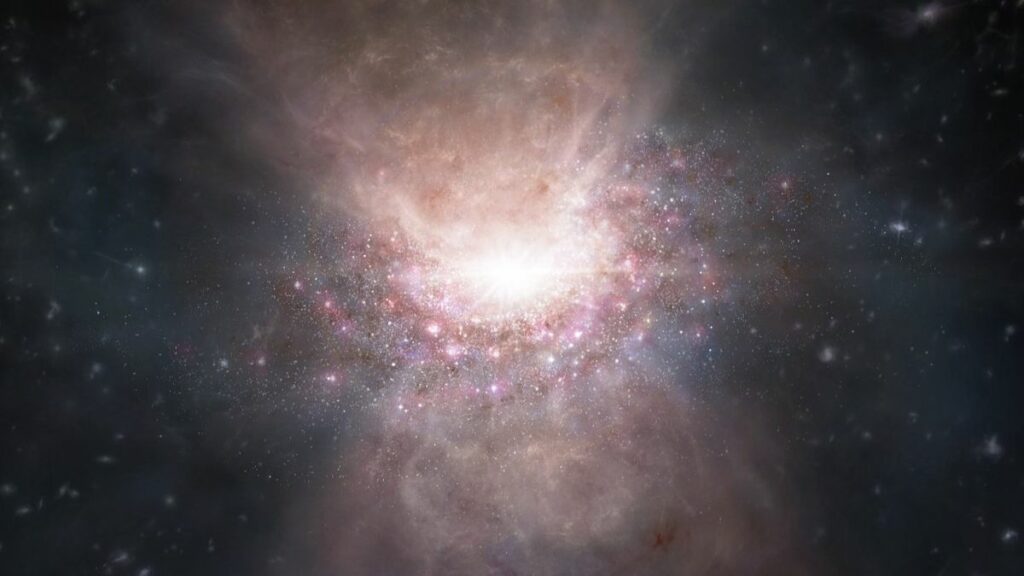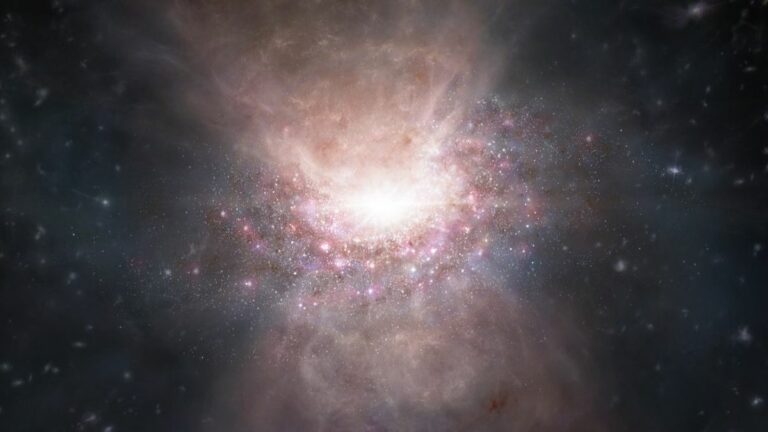Astronomers have detected a colossal black hole that is putting an end to the formation of stars in a galaxy during the early stages of the universe.
Chile’s ALMA telescope has made significant observations, uncovering a colossal quasar that is suppressing the formation of stars in a galaxy. This groundbreaking discovery marks the first of its kind in the early universe.

Astronomers have made a groundbreaking discovery, observing a supermassive black hole from ancient times that is responsible for halting the formation of stars in a galaxy at the beginning of the universe.
This remarkable cosmic event occurred a mere 900 million years after the Big Bang, providing concrete evidence for the theoretical predictions that highly luminous black holes, known as quasars, impede star formation by expelling rapid streams of gas at high speeds.
These torrents of molecular gas, consisting of hydrogen bonded with oxygen, serve as the primary source of fuel for the birth of stars. However, by expelling gas that moves too swiftly to be consumed by developing stars, quasars suppress the ability of stars to form in the surrounding area. The researchers have documented their findings in the Astrophysical Journal, with the publication date of February 1st.
According to Dragan Salak, an assistant professor of astrophysics at Hokkaido University in Japan, molecular gas outflows are believed to have a significant impact on the formation and development of galaxies since they can regulate star formation. He further stated that quasars, being highly energetic sources, were expected to have the ability to generate powerful outflows.
Black holes originate from the collapse of massive stars and increase in size by consuming gas, dust, stars, and other black holes. In certain cases, the material spiraling into these voracious cosmic entities heats up due to friction, resulting in the emission of detectable light that can be observed by telescopes. This process transforms them into active galactic nuclei (AGN), commonly known as quasars.
Quasars, which are supermassive black holes billions of times more massive than the sun, expel their gaseous envelopes by emitting light blasts that are trillions of times brighter than the most luminous stars.
In addition to emitting powerful beams of light that push gas outward, quasars have the ability to expel nearby matter at speeds close to that of light after spinning it around their event horizons. While this process has been observed in the nearby universe, astronomers were uncertain if it occurred during the early stages of the cosmos.
To investigate the impact of this process on star formation and the formation of early galaxies, astronomers focused the Atacama Large Millimeter/submillimeter Array (ALMA) telescope in Chile on the distant quasar J2054-0005, which was observed approximately 1 billion years after the Big Bang.
Salak explained, “We discovered the outflowing molecular (OH) gas through absorption. This means that we did not directly observe microwave radiation emitted by the OH molecules. Instead, we observed the radiation emitted by the bright quasar, and the absorption indicated that the OH molecules absorbed a portion of the quasar’s radiation. It was like detecting the presence of gas by observing the ‘shadow’ it created in front of the light source.”
With the confirmation of this phenomenon, astronomers will continue to search for more quasars in the early universe to gain a better understanding of how the powerful cores of massive black holes shaped the very first galaxies.
Do not forget to share your opinion with us to provide you with the best posts !





0 Comments